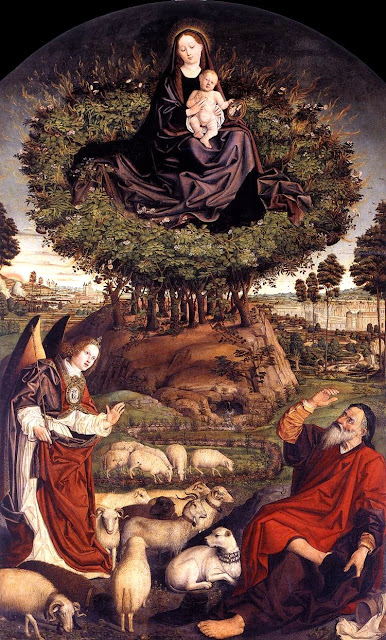"In the sixth month,
the angel Gabriel was sent from God
to a town of Galilee called Nazareth,
to a virgin betrothed to a man named Joseph,
of the house of David,
and the virgin's name was Mary.
And coming to her, he said,
"Hail, full of grace! The Lord is with you."
But she was greatly troubled at what was said
and pondered what sort of greeting this might be.
Then the angel said to her,
"Do not be afraid, Mary,
for you have found favor with God.
Behold, you will conceive in your womb and bear a son,
and you shall name him Jesus.
He will be great and will be called Son of the Most High,
and the Lord God will give him the throne of David his father,
and he will rule over the house of Jacob forever,
and of his Kingdom there will be no end."
But Mary said to the angel,
"How can this be,
since I have no relations with a man?"
And the angel said to her in reply,
"The Holy Spirit will come upon you,
and the power of the Most High will overshadow you.
Therefore the child to be born
will be called holy, the Son of God.
And behold, Elizabeth, your relative,
has also conceived a son in her old age,
and this is the sixth month for her who was called barren;
for nothing will be impossible for God."
Mary said, "Behold, I am the handmaid of the Lord.
May it be done to me according to your word."
Then the angel departed from her.
(Luke 1: 26-38)
Today (and on the Fourth Sunday of Advent) the Church reads, as the Gospel of the Mass, St. Luke's description of the point at which time divides. From this moment, there is time before and time after, whether you call the periods on either side Before Christ (BC) or Before the Common Era (BCE) or Anno Domini (AD) or Common Era (CE), the point is the same -- Christ has come into the world. With Mary's statement of acceptance "May it be done to me according to your word" we enter a new place, with new possibilities.
There are countless images of the Annunciation throughout history. Too many, in fact, to write a history of the subject in the brief confines of this blog. Such a note would go on forever! So, I have decided to write about only one image, the panel painting by Fra Angelico now in the Prado. It was painted sometime between 1424 and 1426, possibly for the church of San Lorenzo in Florence, possibly for the Dominican church in Fiesole, where it was historically placed.
1
The 1420s were a time when Guido di Pietro (his Baptismal name), known as Fra Giovanni (the name Angelico was given to him posthumously on account of his paintings and life) was still a fairly young painter with a developing style. At this point he stands on the cusp, as it were, of finding his final style. This painting represents a point at which his earlier, delicately Gothic style was being influenced by the work of another Florentine painter, Masaccio, toward a slightly more monumental direction. This painting is an almost perfect example of the early fusion of these two influences. It is also a beautiful exposition of the implications of the Annunciation.
In this painting we see Mary, seated on a bench draped in fabric which also drapes the wall behind her, forming a kind of cloth of state. She sits in an open, groin-vaulted loggia, an open prayer book on her knee, and responds gently to the approach of Gabriel, her gesture mirroring his.

Gabriel appears to have just landed, his wings still half open, his knees just beginning to bend.
From the upper left corner of the picture, the hands of God send streams of golden light toward her and, on those beams, the Holy Spirit is seen as a dove descending (just above Gabriel's head).
2

Above the column that divides Gabriel and Mary is an image of Jesus, presented as a bust in relief. So all Persons of the Trinity appear in some way within the picture.
On Mary's side of the space, seated on the iron cross bar between the pillars, is a swallow, symbolic of the Incarnation.
The entire left side of the painting is occupied by a garden filled with highly detailed representations of plant life. And, in this garden appears the scene from Genesis of Adam and Eve being driven out of the Garden of Eden by an angel. We see here the tipping point of salvation history. Mary is being invited to participate in righting the wrong done by Adam and Eve. Her obedient
fiat (Be it done to me) will cancel their disobedience in eating the forbidden fruit.
The painting represents the moment just before the world begins anew. Mary's yes will begin it again, with Jesus as the new Adam and Mary herself as the new Eve in a new Garden of Eden of the spirit.
© M. Duffy, 2011
______________________________________
1. Kanter, Laurence. "Fra Angelico: A Decade of Transition (1422-32)" in
Fra Angelico, New York, New Haven and London, The Metropolitan Museum of Art and Yale University Press, 2005, pp. 80-83. This is the catalogue of an exhibition of the work of
Fra Angelico held at the Metropolitan Museum of Art in New York, October 26, 2005 - January 29, 2006.
2. Ferguson, George.
Signs and Symbols in Christian Art, New York, Oxford University Press, 1966, pp. 25-26.




































_ca.%201270_Finding%20of%20Moses%20&%20Burning%20Bush_BNF_Latin%2010525,%20fol.29v_2.jpg)


















